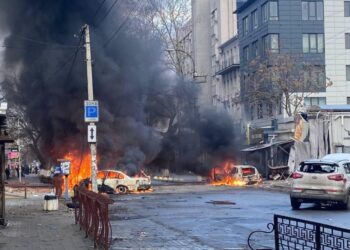
Tens of thousands of homes are without power and sea water is sloshing through coastal streets as Hurricane Florence begins lashing the US East Coast.
The hurricane is moving towards land with maximum sustained wind speeds of 90mph (150 km/h).
It lost power as it approached North and South Carolina, but officials warn it could still kill “a lot of people” with risks of “catastrophic” flooding.
Evacuation orders are in place for more than a million people.
Thousands had taken shelter in emergency facilities by Thursday night.
Photographs showed residents crowded into corridors with blankets on inflatable mattresses and mats.
The governor of North Carolina, where Florence is expected to make landfall at noon local time on Friday, said surviving the storm would be a test of “endurance, teamwork, common sense, and patience”.
“The first bands of the storm are upon us but we have days more to go,” Roy Cooper said.
National Weather Service forecaster Brandon Locklear said North Carolina is likely to see eight months’ worth of rain in two to three days.
How dangerous is it?
Conditions deteriorated throughout Thursday. Some areas of North Carolina saw almost a foot of rain just a few hours, and footage showed sea levels begin to surge in land.
At 23:00 local time (03:00 GMT) the National Hurricane Centre (NHC) said wind speeds had slightly lowered, making it a category one hurricane.
The NHC says that despite the gradual lowering in wind strength, the storm remains extremely dangerous because of the high volume of rainfall and storm surges predicted.
“Inland flooding kills a lot of people, unfortunately, and that’s what we’re about to see,” said Brock Long, head of the Federal Emergency Management Agency (Fema).
He said that people living near rivers, streams and lowland areas in the region were most at risk.
How bad is it expected to get?
The latest weather predictions show the storm slowing to a near standstill as it pummels the coast with “copious amounts of rain” from Thursday night to Saturday.
Wind speeds are only expected to weaken on Saturday as the storm moves slowly across land.
Meteorologists have warned floodwaters may rise up to 13ft (4m) in areas as some rivers see their flows “reversed”.
Parts of the Carolina coast are expecting 20-30in (50-75cm) of rain, with isolated regions receiving up to 40in of downpour.
Myrtle Beach, South Carolina, is imposing a 12-hour curfew from 19:00 local time on Thursday.
Petrol stations in the area are reporting shortages. Energy companies predict that one to three million homes and businesses may lose power.
Officials have warned restoring electricity could take days or even weeks.
Over 1,400 flights have been cancelled, according to FlightAware.com, as most of the coastal region’s airports are closed to ride out the storm.
Emergency workers are arriving from other parts of the US to aid in rescues.
–













